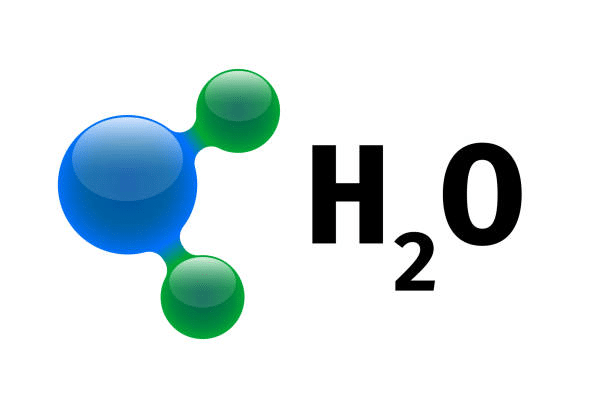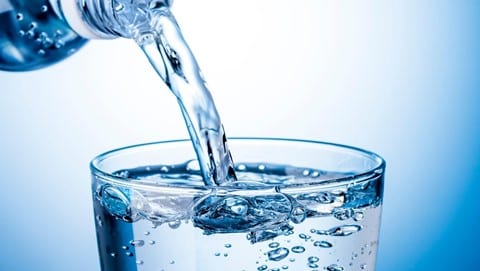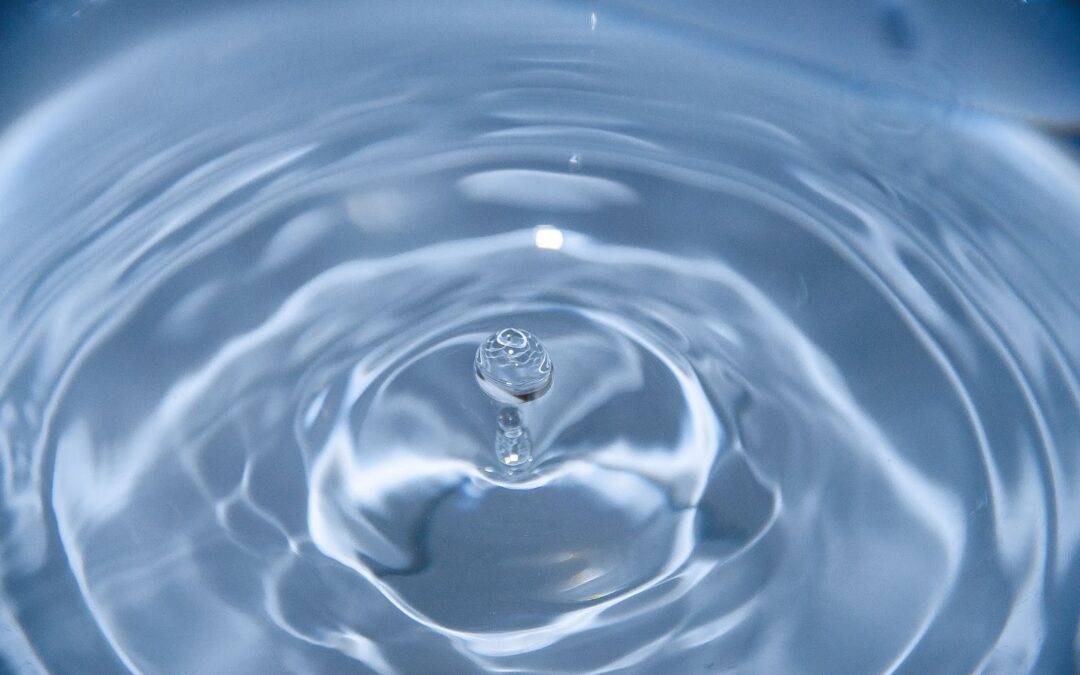Water is everywhere on our planet, and its significance goes beyond just quenching thirst. In our exploration into the science of water, we’ll dive into its basic molecular structure, discover its roles in different states—from liquid to ice to vapor—and understand its unmatched ability to dissolve a multitude of substances. By the end, the many ways water impacts our world, both big and small, will become clear.
The Basic Structure Of Water Molecules

Water, a fundamental element for life as we know it, possesses a seemingly simple yet intricate structure represented by the formula H2O. This signifies that each water molecule consists of two hydrogen atoms bonded to one oxygen atom. The hydrogen atoms are positioned at an angle of about 104.5 degrees relative to the oxygen atom, giving the water molecule a bent or V-shaped structure.
The bonds formed between the hydrogen and oxygen atoms are covalent in nature, meaning electrons are shared between the atoms. Oxygen, being more electronegative, attracts the shared electrons more strongly, creating a partial negative charge on the oxygen end of the molecule and a partial positive charge on the hydrogen ends.
This uneven distribution of charge leads to the molecule’s polar nature, which significantly influences its properties and interactions with other molecules and ions.
Hydrogen Bonding In Water Molecules
Hydrogen bonding is a type of attractive interaction that occurs when a hydrogen atom bonded to a highly electronegative atom, like oxygen, is near another electronegative atom. In the context of water molecules, the partially positive hydrogen atoms are attracted to the partially negative oxygen atoms of neighboring water molecules, forming hydrogen bonds. This bonding is weaker than covalent bonding but is crucial in determining the properties and behavior of water.
The presence of hydrogen bonding imparts water with several unique and essential properties. It is responsible for water’s high boiling and melting points compared to other molecules of similar size, as additional energy is required to break these bonds.
Hydrogen bonding also leads to water’s high heat capacity, allowing it to absorb and release large amounts of heat with minimal temperature change, playing a pivotal role in regulating Earth’s climate. Additionally, these bonds contribute to water’s cohesive and adhesive properties, enabling phenomena such as capillary action and surface tension, which are vital for life and the environment.
Water in Three States
Liquid Water
In its liquid phase, water exhibits a range of remarkable characteristics. The molecules are closely packed, yet they can move freely, allowing liquid water to flow and take the shape of its container. The presence of hydrogen bonding makes liquid water a great conductor of heat, and its high specific heat capacity enables it to store substantial amounts of energy, essential for the human body.
The high specific heat capacity of liquid water signifies its ability to absorb and retain heat, undergoing only minimal temperature variations in the process. This characteristic is crucial for maintaining Earth’s climate stability and supporting life, as it helps moderate temperature extremes between day and night, and between seasons, ensuring a stable supply of drinking water for the human body.
Ice And Its Unique Properties
One of the anomalous properties of water is that its solid state, ice, floats on its liquid state. This occurs because, as water freezes, the hydrogen bonds lock the water molecules into a crystalline lattice structure, causing the molecules to be spaced further apart, making ice less dense than liquid water.
The floating property of ice plays a vital role in preserving aquatic life. By insulating the water below, ice prevents water bodies from freezing solid in cold temperatures, thereby providing a stable environment for marine organisms to survive and thrive.
Water Vapor And The Water Cycle
Water vapor is the gaseous state of water and is a key component of the global water cycle. It is responsible for the processes of evaporation and transpiration, contributing to cloud formation and precipitation, which are integral for distributing fresh water across the Earth’s surface.
The water cycle is essential in regulating Earth’s climate and sustaining ecosystems. It redistributes water and energy across the globe, influences weather patterns, and ensures the availability of fresh water, which is fundamental for the survival of terrestrial and aquatic ecosystems.
The intricate dance of the water cycle is not only vital for maintaining the balance of earth’s water but also plays a significant role in the climatic equilibrium of our solar system.
Must Read: Water Conservation Tips For A Greener Tomorrow
Phase Changes And Energy
Hydrogen bonds between water molecules significantly influence the boiling and freezing points of water. The energy required to break these bonds results in water having a higher boiling point and a higher freezing point compared to other similarly sized molecules.
During phase changes, water undergoes energy interactions, absorbing or releasing latent heat. When water transitions from a solid to a liquid or from a liquid to a gas, it absorbs energy from the surroundings, whereas it releases energy when transitioning from a gas to a liquid or from a liquid to a solid.
Interaction With Other Chemicals
Water’s polar nature and ability to form hydrogen bonds make it a universal solvent, capable of dissolving a wide variety of substances. This leads to various chemical reactions, as ions and molecules dispersed in water interact with one another, forming new compounds.
The interactions of water with various chemicals are vital for life and the environment. They facilitate nutrient absorption, transport, and chemical synthesis within living organisms, and play a key role in ecological processes such as nutrient cycling and the purification of water bodies.
Water As The Universal Solvent

The term “universal solvent” refers to water’s unique ability to dissolve a vast array of substances, a characteristic attributed to its polar nature and the presence of hydrogen bonding. These properties enable water to disrupt the attractive forces that hold molecules or ions together, leading to their dispersion in water.
Water can dissolve salts, sugars, acids, bases, and gases, making it exceptionally versatile. While it cannot dissolve everything—oily and nonpolar substances are resistant—it remains unparalleled in its solvency capabilities, underscoring its designation as the universal solvent.
Solubility of Substances In Water
The solubility of substances in water varies widely. While polar and ionic compounds tend to be highly soluble, nonpolar compounds like oils and fats are not. Temperature and pressure also influence solubility, with some substances showing increased solubility with rising temperature, while others exhibit the opposite trend.
The diverse solubility of substances in water impacts both natural and industrial processes. It affects the availability of nutrients in ecosystems, the distribution of minerals in the Earth’s crust, and the efficiency of industrial processes such as extraction, purification, and chemical synthesis.
Impact on Chemical Reactions
Water not only acts as a medium for chemical reactions but also participates actively in many reactions. It can act as a reactant, a product, or a catalyst, influencing reaction rates and equilibrium, and facilitating biochemical transformations essential for life.
The role of water in chemical reactions has far-reaching implications. In biochemistry, it enables enzymatic reactions and metabolic pathways that sustain life. In environmental science, it participates in weathering, nutrient cycling, and pollutant degradation, shaping the Earth’s surface and ecosystems.
Water’s Anomalous Properties
High Specific Heat Capacity
Specific heat capacity is a property that defines the amount of heat energy required to raise the temperature of a substance by one degree Celsius. Water has a remarkably high specific heat capacity, meaning it can absorb and store a significant amount of heat energy before experiencing a change in temperature.
This is primarily due to the hydrogen bonding between water molecules, which requires more energy to break.
The high specific heat capacity of water has profound effects on both the environment and living organisms. It moderates Earth’s climate by absorbing and releasing heat, mitigating temperature fluctuations and creating stable ecosystems. For living organisms, it helps in maintaining body temperature and protects cells from rapid temperature changes, supporting life across various climates and conditions.
Expansion Upon Freezing
Unlike most substances, water expands upon freezing. When water cools, the hydrogen bonds adjust to hold the negatively charged oxygen atoms apart, resulting in a hexagonal lattice structure in ice, which is less dense than liquid water. This anomaly means that ice floats on water.
The expansion of water upon freezing has significant environmental implications. It ensures that ice forms on the surface of bodies of water, providing insulation and maintaining a stable aquatic environment beneath the ice. This phenomenon protects aquatic life during winter and contributes to the regulation of Earth’s climate.
Cohesion And Adhesion
Cohesion refers to the attraction between molecules of the same substance, while adhesion is the attraction between molecules of different substances. In water, cohesion results from hydrogen bonding between water molecules, and it’s exhibited in phenomena like surface tension.
Adhesion occurs when water molecules are attracted to other substances, such as the walls of a narrow tube, leading to capillary action.
The cohesive and adhesive properties of water have numerous real-world applications and significance. They facilitate the transport of water against gravity in plants through capillary action, contributing to the survival of terrestrial ecosystems. These properties also influence weather patterns, cloud formation, and precipitation, playing a crucial role in the water cycle and environmental sustainability.
Conclusion
Reflecting on the journey through the science of water, it becomes unequivocally clear that each chemical property, each anomaly, and each interaction is a testament to water’s overarching significance.
Water isn’t just a simple molecule; it’s a symphony of interactions and properties, harmoniously orchestrating life and shaping the world we inhabit. From the smallest organism to the largest ocean, from the coldest ice cap to the warmest equator, water’s chemical properties are the unsung heroes, enabling life, shaping climates, and making Earth a uniquely habitable place in the vastness of the cosmos.
For those who recognize the parallel importance of a good night’s rest in our health journey, visit the Resway shop here to explore CPAP accessories that enhance sleep quality. Just as water is life’s true elixir, restorative sleep is the bedrock of wellness.
What are the main insights you gathered from this read?




